

In my Project Management Professional (PMP®) sessions, I observed many get confused in Precedence Diagramming Method relationship types. They find Finish to start (FS) relationships more natural to understand and practice. But, the other three confuses them somehow.
Also, the most obvious question is – how do you show dependencies in a project plan? The answer lies in the understanding of the Precedence Diagramming Method (PDM):
Precedence Diagramming Method is one of the Project Schedule Network Diagrams.
And the Project Schedule Network Diagram is the graphical representation of the logical relationships among the project schedule activities.
Technique used for making a schedule model in which activities are represented by nodes and are graphically linked by one or more logical relationships to show the sequence in which the activities are to be performed.
In simple words –
After identification of activities, we analyze them if any relationships exist between those. If relationships exist, it is better to show them to maintain the project schedule better.
The relationship exists between the two activities. Let’s take two activities for understanding the concept and name the activity A and B.
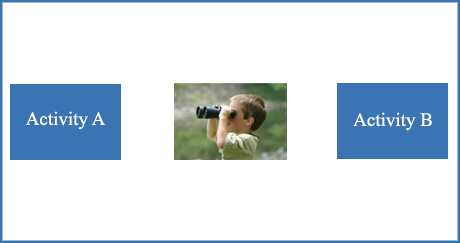
Here, activity A is a predecessor, and activity B is the successor activity. If something happens to the predecessor activity, it impacts the successor activities. In this way, successor activity B is a dependent activity on the predecessor activity A. So, you can see here – A is an independent activity. Activity A logically comes before activity B in the schedule. The relationships between A and B activity are either of four types:
We define these four relations by two charters (XX) using F or S.
We link the predecessor (Activity A) with the first character. It defines the state of processor activity. And, in the same way, we link successor (Activity B) with the second character. The character defines the rule which we have to apply on the successor activity.
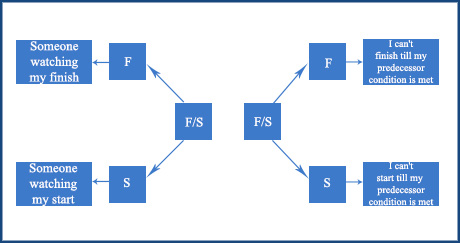
Let’s discuss these four relationships one by one:
“A logical connection in which a successor venture cannot start until a predecessor activity has finished.”
If you have a question – which is the most commonly used logical relationship? Yes, Finish to Start is the most commonly used logical relationship.
You can see, this relation constraint does not impact the independent activity. It only affects the dependent, so in our case, it is activity B.
Here the next question is – what does FS mean in project management?
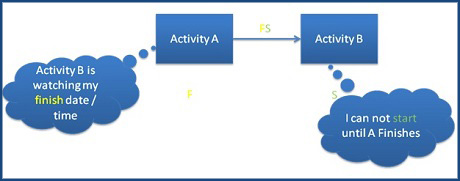
Finish-to-start (FS)
From this FS relationship, F shows the finish state of activity A, and at this state, activity B can be started. The second character ‘S’ is the rule on a successor to make it dependent on the Finish state of the successor activity.
Let’s take an Example –
You cannot start development until you finish the design. Here, development is the dependent activity on the design activity. Design is the predecessor activity, and its finish state can only start the development activity.
As per the PMBOK® Guide
“A logical relationship in which a successor activity cannot start until a predecessor activity has started.”
So if activity B is bound to this relation, this means it cannot start till the predecessor (independent) activity A is started. The predecessor activity B start is dependent on the start state of successor activity A. The start of activity A drives the start of activity B.
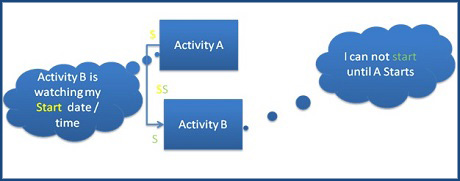
Start-to-start (SS)
Example:
The activity of marketing brochure preparation cannot start until user documentation has begun. In this way, after the commencement of activity A, both A and B can go in parallel.
If you are curious to know in what could be the practical cases to make activity B dependent on the start state of activity A –
Watch the video attached at the end of this blog.
As per the PMBOK® Guide
“A logical relationship in which a successor activity cannot finish until a predecessor activity has finished.”
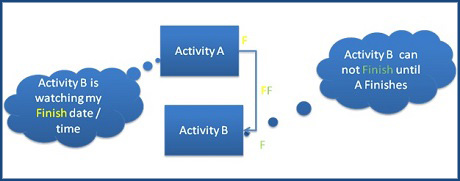
Finish to Finish (FF)
So if activity B is bound with this relation it means it cannot finish till the predecessor (independent) activity A is finished. So, B needs to finish its deliverable and keep working with A till the time A is not done.
Like, the broadcast of a football match cannot finish until the match is finished. So the match is not depended in broadcast, but the broadcast is. If the match takes longer than the initially estimated time broadcast will also continue till that time.
It could be possible that the broadcast is continued even after the match is finished. The broadcast could be continued to discuss highlights and other things. It means it will end after successor activities but necessarily immediately.
As per the PMBOK® Guide
“A logical connection in which a successor activity cannot finish until a predecessor activity has started.”
So if activity B is bound to this relation in which it cannot finish till the independent activity A starts. It looks confusing because in typical cases, predecessor activity gets performed before the successor activity. But, in this case, the successor is happening first. But even if the successor is happening first, the predecessor is not at all restricted by successor activity. It is independent. But the successors (Activity B) cannot finish till the predecessor starts (Activity A starts)
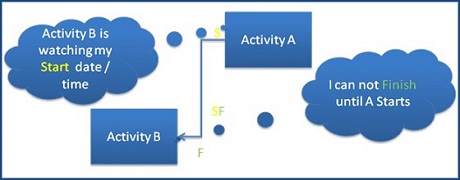
Start-to-finish (SF)
An example from PMBOK® Guide only
“The initial security guard shift (successor) cannot finish until the second security guard shift (predecessor) starts.”
It is crucial to understand the basic concepts underlying these four logical relationships or dependencies between project activities. So, make sure you work on them right from the start and discuss all the tasks and schedule them accordingly.
I hope this blog has sufficiently answered your all queries related to Precedence Diagram Method (PDM) – logical relationships or dependencies. You can post follow up questions here on our Discussion Forum. You can also log in to our YouTube channel watch the video on the related topics.
You may also like to watch a video explaining PDM- logical relationships or dependencies. This video gives ample of examples for all four types of relationships including an idea of how you can apply lead and lag in these logical relationships:
| Name | Date | Place | – |
| PMP Certification and Training | 17 July – 15 Aug 2025 | Bangalore | More Details |